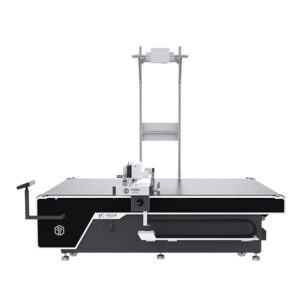Ensuring consistency in cutting across different batches of automatic leather involves the implementation of various measures to maintain precision, accuracy, and uniformity throughout the cutting process.
Here are key factors and strategies that contribute to achieving consistency in cutting when using automatic leather cutting machines:
- Calibration and Setup:
- Regular calibration of the automatic leather cutting machine is essential to ensure that it is set up accurately. Calibration includes checking and adjusting cutting parameters, tool alignment, and other relevant settings to maintain consistency.
- Material Inspection:
- Before the cutting process begins, an automatic leather cutting machine may incorporate material inspection systems to assess the characteristics of the leather. This includes checking for variations in thickness, surface irregularities, and other factors that could impact cutting consistency.
- Batch Identification and Programming:
- Each batch of leather may have unique characteristics, such as color, texture, or thickness variations. The cutting machine can be programmed to recognize and adapt to these variations based on batch identification, ensuring that cutting parameters are adjusted accordingly.
- Automatic Nesting Algorithms:
- Automatic nesting algorithms optimize the placement of patterns on the leather sheets to maximize material utilization and minimize waste. These algorithms can also consider the unique characteristics of each batch, ensuring efficient and consistent cutting.
- Vision Systems for Pattern Recognition:
- Vision systems equipped with cameras are used to recognize and align cutting patterns with the contours of the leather. These systems contribute to accurate placement and help maintain consistency across different batches.
- Cutting Tool Maintenance:
- Regular maintenance of cutting tools is crucial for consistent cutting performance. Dull or damaged blades can lead to variations in cut quality. The machine may include features for automatic tool change and alert operators when maintenance is required.
- Dimensional Measurement Systems:
- Dimensional measurement systems, such as laser sensors or contact probes, can be employed to measure the dimensions of cut pieces. This ensures that the cut leather components meet the specified tolerances and dimensions consistently.
- Real-Time Monitoring and Feedback:
- Real-time monitoring of the cutting process allows the machine to make dynamic adjustments based on feedback. If deviations from the desired parameters are detected, the system can correct them immediately to maintain cutting consistency.
- Statistical Process Control (SPC):
- Implementing statistical process control techniques involves monitoring key process parameters and analyzing statistical data. SPC helps identify variations and ensures that the cutting process remains within specified control limits, promoting consistency.
- Material Handling Systems:
- Consistent material handling is crucial for maintaining cutting accuracy. Automated material handling systems can ensure that leather sheets are presented to the cutting machine in a uniform manner, reducing variations in cutting results.
- Quality Control Checks:
- Integrating quality control checks at various stages of the cutting process helps identify any inconsistencies. automatic leather cutting machine These checks may include visual inspections, dimensional measurements, and other criteria to validate the quality of cut pieces.
- Adaptive Control Systems:
- Adaptive control systems utilize feedback from sensors and inspection systems to dynamically adjust cutting parameters based on real-time conditions. This adaptability enhances the machine’s ability to maintain consistency across different batches.
- Operator Training and Oversight:
- Proper training of machine operators is essential for ensuring consistent cutting results. Operators should be familiar with the machine’s capabilities, settings, and maintenance procedures. Oversight by trained personnel contributes to consistent operation.
- Batch Records and Traceability:
- Maintaining detailed records of cutting parameters and results for each batch of leather allows for traceability. If inconsistencies arise, batch records can be analyzed to identify and address the root causes.
By incorporating these measures, automatic leather cutting machines can achieve and maintain consistency in cutting across different batches of leather. The combination of advanced technologies, monitoring systems, and quality control practices contributes to the production of high-quality and uniform leather components. Regular maintenance, calibration, and continuous improvement efforts further enhance the reliability and performance of the cutting process.
